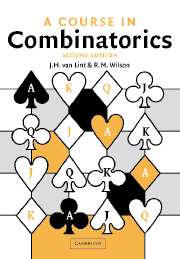Book contents
- Frontmatter
- Contents
- Preface to the first edition
- Preface to the second edition
- 1 Graphs
- 2 Trees
- 3 Colorings of graphs and Ramsey's theorem
- 4 Turán's theorem and extremal graphs
- 5 Systems of distinct representatives
- 6 Dilworth's theorem and extremal set theory
- 7 Flows in networks
- 8 De Bruijn sequences
- 9 Two (0, 1, ⋆) problems: addressing for graphs and a hash-coding scheme
- 10 The principle of inclusion and exclusion; inversion formulae
- 11 Permanents
- 12 The Van der Waerden conjecture
- 13 Elementary counting; Stirling numbers
- 14 Recursions and generating functions
- 15 Partitions
- 16 (0, 1)-Matrices
- 17 Latin squares
- 18 Hadamard matrices, Reed–Muller codes
- 19 Designs
- 20 Codes and designs
- 21 Strongly regular graphs and partial geometries
- 22 Orthogonal Latin squares
- 23 Projective and combinatorial geometries
- 24 Gaussian numbers and q-analogues
- 25 Lattices and Möbius inversion
- 26 Combinatorial designs and projective geometries
- 27 Difference sets and automorphisms
- 28 Difference sets and the group ring
- 29 Codes and symmetric designs
- 30 Association schemes
- 31 (More) algebraic techniques in graph theory
- 32 Graph connectivity
- 33 Planarity and coloring
- 34 Whitney Duality
- 35 Embeddings of graphs on surfaces
- 36 Electrical networks and squared squares
- 37 Pólya theory of counting
- 38 Baranyai's theorem
- Appendix 1 Hints and comments on problems
- Appendix 2 Formal power series
- Name Index
- Subject Index
32 - Graph connectivity
Published online by Cambridge University Press: 05 June 2012
- Frontmatter
- Contents
- Preface to the first edition
- Preface to the second edition
- 1 Graphs
- 2 Trees
- 3 Colorings of graphs and Ramsey's theorem
- 4 Turán's theorem and extremal graphs
- 5 Systems of distinct representatives
- 6 Dilworth's theorem and extremal set theory
- 7 Flows in networks
- 8 De Bruijn sequences
- 9 Two (0, 1, ⋆) problems: addressing for graphs and a hash-coding scheme
- 10 The principle of inclusion and exclusion; inversion formulae
- 11 Permanents
- 12 The Van der Waerden conjecture
- 13 Elementary counting; Stirling numbers
- 14 Recursions and generating functions
- 15 Partitions
- 16 (0, 1)-Matrices
- 17 Latin squares
- 18 Hadamard matrices, Reed–Muller codes
- 19 Designs
- 20 Codes and designs
- 21 Strongly regular graphs and partial geometries
- 22 Orthogonal Latin squares
- 23 Projective and combinatorial geometries
- 24 Gaussian numbers and q-analogues
- 25 Lattices and Möbius inversion
- 26 Combinatorial designs and projective geometries
- 27 Difference sets and automorphisms
- 28 Difference sets and the group ring
- 29 Codes and symmetric designs
- 30 Association schemes
- 31 (More) algebraic techniques in graph theory
- 32 Graph connectivity
- 33 Planarity and coloring
- 34 Whitney Duality
- 35 Embeddings of graphs on surfaces
- 36 Electrical networks and squared squares
- 37 Pólya theory of counting
- 38 Baranyai's theorem
- Appendix 1 Hints and comments on problems
- Appendix 2 Formal power series
- Name Index
- Subject Index
Summary
For k ≥ 2, a graph G is said to be k-vertex connected, or simply k-connected, when |V(G)| ≥ k + 1 and the removal of any k − 1 vertices (and any incident edges) from G does not result in a disconnected graph. We use 1-connected as a synonym for connected.
If a graph G with at least k + 1 vertices is not k-connected and the deletion of a set S of k − 1 vertices disconnects it, there is a partition of V(G) \ S into nonempty sets X, Y with no edges crossing (one end in X, one in Y). Let H and K be the subgraphs induced by X ∪ S and Y ∪ S, except that edges with both ends in S are to be put in one and only one of H or K. Then we obtain edge-disjoint subgraphs H and K whose union is G and such that |V(H)∩V(K)| = k − 1. Conversely, if such subgraphs H and K exist and each contains at least one more vertex than their intersection, then G is not k-connected.
A graph is said to be nonseparable when it is 2-connected and has no loops, or when it is a bond-graph (with two vertices and any positive number of edges joining them, including the link-graph with one such edge), a loop-graph (one edge joining a single vertex to itself), or a vertex-graph. All polygons, for example, are nonseparable; path-graphs or other trees with at least two edges are not.
- Type
- Chapter
- Information
- A Course in Combinatorics , pp. 451 - 458Publisher: Cambridge University PressPrint publication year: 2001

